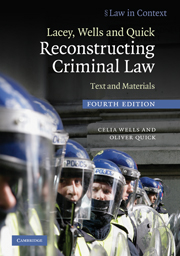Book contents
- Frontmatter
- Contents
- Preface
- Table of cases
- Table of statutes
- Section I Approaching Criminal Law
- Section II Law, Order and Security
- Section III Interpersonal Violence; Drugs and Alcohol Abuse; Offence Preparation and Participation
- Section IV Property and Propriety
- Section V Regulating Sexuality and Bodily autonomy
- Section VI Making a Killing
- 18 The Social Construction of Violence and Personal Harm
- 19 The Criminal Regulation of Public Safety
- 20 Homicide
- 21 Murder and Manslaughter
- Bibliography
- Index
- References
18 - The Social Construction of Violence and Personal Harm
from Section VI - Making a Killing
Published online by Cambridge University Press: 05 June 2012
- Frontmatter
- Contents
- Preface
- Table of cases
- Table of statutes
- Section I Approaching Criminal Law
- Section II Law, Order and Security
- Section III Interpersonal Violence; Drugs and Alcohol Abuse; Offence Preparation and Participation
- Section IV Property and Propriety
- Section V Regulating Sexuality and Bodily autonomy
- Section VI Making a Killing
- 18 The Social Construction of Violence and Personal Harm
- 19 The Criminal Regulation of Public Safety
- 20 Homicide
- 21 Murder and Manslaughter
- Bibliography
- Index
- References
Summary
Conceptions of violence
The term ‘violence’ is rarely found in statutory definitions, although, as we saw in our exploration of violence in the public order context, the Public Order Act 1986 provides an exception (see Chapter 6). Violence, however, is a concept which informs and underlies the practice of criminal law. For example, robbery is treated more seriously than theft because it involves the use of direct force. Violence is hidden in other ways. Road traffic offences exist in part to protect people from injury, yet until the emergence of ‘road rage’ they were never perceived as being connected with the stereotype of violent behaviour; academic studies of criminal law routinely ignore road traffic offences. This academic sidelining, as though the issues raised were inherently less interesting than the intellectual challenge of theft of a wild anemone or criminal damage of a greenhouse, reflects their wider marginalisation from issues of serious concern.
As the next two extracts emphasise, violence has to be viewed as historically, culturally and situationally contingent: it does not define itself. As Cotta argues, ideas and images of violence are contested and changing. Perceptions of violence are affected by changes in ‘space, time and field’. We live in an era of intensive communication and increased mobility, which has rendered ‘space’ less fixed. Into this continuous and continuing space, the concept of ‘time’ has become compressed so that news is conveyed almost contemporaneously.
- Type
- Chapter
- Information
- Lacey, Wells and Quick Reconstructing Criminal LawText and Materials, pp. 643 - 653Publisher: Cambridge University PressPrint publication year: 2010



